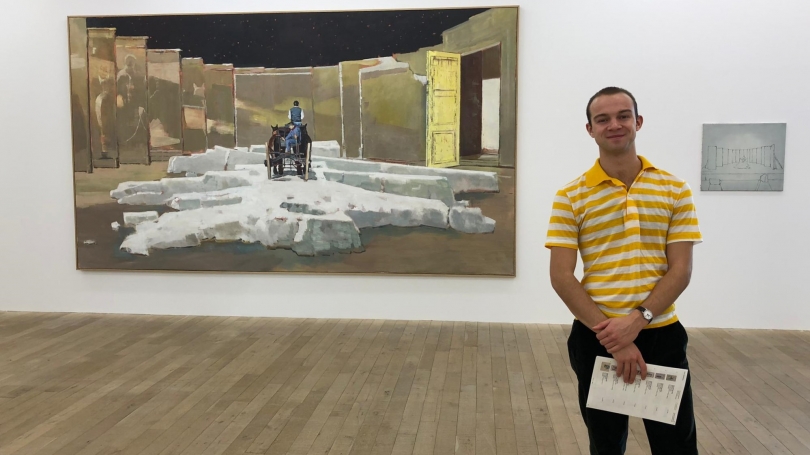Hadley Detrick '22, Museum Club member and social media assistant at the Hood Museum, spent his winterim break job-shadowing Conservator Jean Rosston '77, whom he met at a recent Hood Museum symposium.
This past October, the Hood Museum of Art hosted a symposium called The New Now: Art, Museums, and the Future--an opportunity for students, faculty and Upper Valley community members to hear from Dartmouth alumni who have built careers in the museum field. As a student involved in the Hood's Museum Club and an art history major, I was invited to enjoy a luncheon with these alumni and gather valuable career insights.
Jean Rosston '77 and I met at this luncheon and hit it off pretty quickly. While originally raised in California, Jean has lived in Zurich, Switzerland, for the past thirty-two years, where she works in the Conservation Department at the internationally recognized Kunsthaus Zurich Museum of Art. Before coming to Dartmouth, I lived in California until I was 13, at which point I also moved to Zurich for a few years.
During the lunch, the topics ranged from archeology to women's rowing, before shifting to Dartmouth's D-Plan and the ample time it allows students to pursue meaningful experiences between fall and winter terms. Eager to make the most of my winter break (the only thing that I had planned was skiing and sleeping), I floated the idea of completing something like a job-shadow with Jean at the Kunsthaus. We decided to meet the next day to continue the conversation.
What I didn't know at the time was that this conversation also served as an informal interview of sorts, where I was being tested on my knowledge of art history, Swiss culture, German language skills, and current practices in conservation. Jean and I talked for over three hours that afternoon, sharing stories, discussing art, and comparing our times at Dartmouth. By around 6:30 pm, Jean told me that she would reach out if any opportunities at the Kunsthaus came up. Frankly, I figured that she was just being polite; why would this woman go out on a limb and pull strings for me?
About a week after the symposium, I sent Jean a message asking if she had given my job-shadow suggestion any more thought. Sure enough, I received a response, asking if I was still interested in working with her. Naturally, I said yes. Although we still needed to figure out the precise dates of my stay, Jean had found an opportunity for me to help.
When I arrived in Zurich, I was under the impression that I was just going to be shadowing Jean and observing the day-to-day routines at the Kunsthaus. I was mistaken. My work at the museum actually consisted of examining artworks, discussing the artists, their materials, and their techniques, and assisting in the preparation of Zustandsrapport (essentially, condition reports) that included suggestions for treatment and future preservation of the works of art. My goal was to help Jean examine and document a collection of donated works from Bruno Giacometti--the brother of Swiss sculptor and artist Alberto Giacometti--and draft a report for each artwork.
Mornings at the Kunsthaus were spent discussing the day's plan with Jean in her atelier. I also had the opportunity to meet with other specialists in the Conservation Department and visit their studios. During the mid-morning break, known as Kaffeepause, I would listen to each specialist give updates on their respective ongoing projects. The rest of the day was spent in the Graphic Collection, documenting works from the Bruno Giacometti donation.
Half of my time in Zurich was devoted to helping draft these Zustandsrapport. The other half was spent traveling around with Jean. Having lived in Zurich for the past thirty-two years, Jean's professional network is vast and diverse. We visited countless galleries, ranging from large, international enterprises to small, local ventures. One Friday, we took the train around Switzerland, visiting the Franz Gertsch Museum in Burgdorf and the Paul Klee Zentrum in Bern. I also had the opportunity to meet with a private art consultant and attend a Christmas party hosted by an art logistics and transportation firm.
With each person I met with and institution I visited, the scope of my understanding of the art world widened. The time that I spent working with Jean exposed me to countless careers relating to art. I encountered many facets of the contemporary art world and met countless fascinating people, from curators to conservators, collectors to consultants. I came to realize that distributing, preserving, and exhibiting art is a complex ordeal that involves many specialists and highly driven people.
To the readers of this essay, this may come as no surprise, but as a twenty-year-old who is entering the job market in a few years, this realization gave me hope that studying art history isn't such a bad idea, especially at such a cutting-edge institution. And yet, I recognize that the institutional support that Dartmouth offers is only part of what makes the College on the Green so special. What's truly important about Dartmouth is its whole host of dedicated individuals like Jean, who feel an obligation to "pay it forward." Working so closely with Jean and meeting her colleagues over my winter break reminded me why I want to work in the arts in the first place.
Written by Hadley Detrick '22, Social Media Assistant
